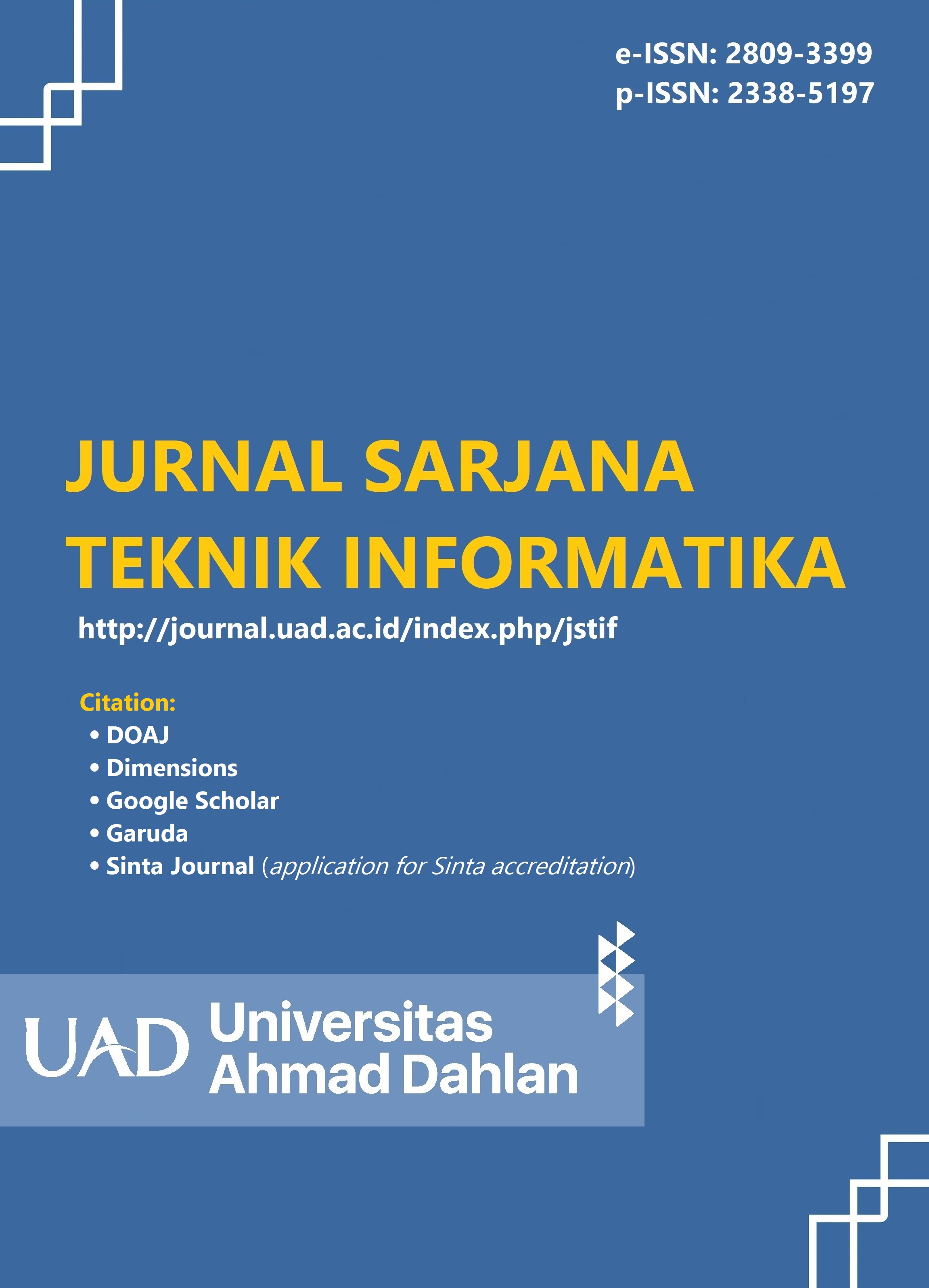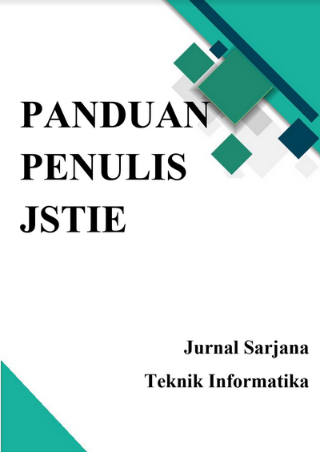Pengenalan Wajah Berdasarkan Emosi Manusia Menggunakan SOM (Self Organizing Map)
DOI:
https://doi.org/10.12928/jstie.v12i3.28620Keywords:
Identifikasi Biometrik, Ekspresi Wajah, Emosi Manusia, Keamanan Teknologi Biometrik, Self Organizing MapAbstract
Identifikasi melalui password atau kartu rentan terhadap lupa dan pencurian, menyebabkan keamanan yang kurang efektif. Sistem identifikasi biometrik, terutama berbasis ekspresi wajah, menjanjikan solusi lebih baik. Namun, tantangan seperti variabilitas ekspresi dan kondisi pencahayaan membatasi efisiensi. Penelitian ini mengusulkan penggunaan Self Organising Map (SOM) untuk mengatasi kendala tersebut. Meskipun telah ada penelitian sebelumnya, penggabungan pengenalan wajah dan emosi dengan SOM masih terbatas. Tujuan penelitian ini adalah mengembangkan sistem pengenalan wajah berdasarkan emosi manusia menggunakan pendekatan SOM. Pendekatan ini tidak hanya meningkatkan keamanan dan kenyamanan tetapi juga membuka peluang baru dalam interaksi manusia dan mesin, pengawasan keamanan, dan pengembangan teknologi sehari-hari. Dengan mengatasi keterbatasan identifikasi konvensional, penelitian ini memperluas potensi teknologi biometrik
References
[1] K. Amda and R. Fitriyani, Membaca ekspresi wajah. Penerbit Genesis, 2019.
[2] F. N. U. R. AZIZI, “Deteksi Emosi Menggunakan Citra Ekspresi Wajah Secara Otomatis,” 2021.
[3] A. S. Sitio and A. Sindar, “Sistem Identifikasi Biometrik Ekpresi Wajah Menggunakan Metode Transformasi Hough,” J. Nas. Komputasi dan Teknol. Inf., vol. 3, no. 3, 2020.
[4] I. P. Sari, F. Ramadhani, A. Satria, and D. Apdilah, “Implementasi Pengolahan Citra Digital dalam Pengenalan Wajah menggunakan Algoritma PCA dan Viola Jones,” Hello World J. Ilmu Komput., vol. 2, no. 3, pp. 146–157, 2023, doi: 10.56211/helloworld.v2i3.346.
[5] S. Helmiyah, I. Riadi, R. Umar, A. Hanif, A. Yudhana, and A. Fadlil, “Identifikasi Emosi Manusia Berdasarkan Ucapan Menggunakan Metode Ekstraksi Ciri LPC dan Metode Euclidean Distance,” J. Teknol. Inf. dan Ilmu Komput., vol. 7, no. 6, 2020.
[6] T. Kohonen, “Essentials of the self-organizing map,” Neural networks, vol. 37, pp. 52–65, 2013.
[7] J. Almotiri, “Face recognition using principal component analysis and clustered self-organizing map,” Int. J. Adv. Comput. Sci. Appl., vol. 13, no. 3, 2022.
[8] T. Kohonen, “The self-organizing map,” Proc. IEEE, vol. 78, no. 9, pp. 1464–1480, 1990.
[9] L. V Fausett, Fundamentals of neural networks: architectures, algorithms and applications. Pearson Education India, 2006.
[10] M. Mittal and K. Kumar, “Energy efficient homogeneous wireless sensor network using self-organizing map (SOM) neural networks,” African J. Comput. & ICT, vol. 8, no. 1, pp. 179–184, 2015.
[11] K. Kumar, “Self-organizing map (SOM) neural networks for air space sectoring,” in 2014 International Conference on Computational Intelligence and Communication Networks, 2014, pp. 1096–1100.
[12] Z. Song and Z. Xia, “Carbon Emission Reduction of Tunnel Construction Machinery System Based on Self-Organizing Map-Global Particle Swarm Optimization With Multiple Weight Varying Models,” IEEE Access, vol. 10, p. 1, 2022, doi: 10.1109/ACCESS.2022.3173735.
[13] S. Haykin, Neural networks and learning machines, 3/E. Pearson Education India, 2009.
[14] S. N. Kapita, A. Mubarak, S. Do Abdullah, and M. Fhadli, “Penerapan Algoritma Clustering Khonen-Som Dengan Validasi Davies Bouldin Index Pada Pengelompokan Potensi Udang Di Indonesia,” IJIS-Indonesian J. Inf. Syst., vol. 7, no. 2, pp. 134–143, 2022.
[15] M. R. Berthold and F. Höppner, “On clustering time series using euclidean distance and pearson correlation,” arXiv Prepr. arXiv1601.02213, 2016.
[16] H. Ritter, T. Martinetz, and K. Schulten, Neural Computation and Self-Organizing Maps; An Introduction. Addison-Wesley Longman Publishing Co., Inc., 1992.
Downloads
Published
Issue
Section
License
Copyright (c) 2025 Frederikus Wanforsan Reynaldy Selan, Frederikus Mantolda Dede Owa, Yampi R Kaesmetan

This work is licensed under a Creative Commons Attribution-ShareAlike 4.0 International License.
License and Copyright Agreement
In submitting the manuscript to the journal, the authors certify that:
- They are authorized by their co-authors to enter into these arrangements.
- The work described has not been formally published before, except in the form of an abstract or as part of a published lecture, review, thesis, or overlay journal. Please also carefully read Journal Posting Your Article Policy.
- The work is not under consideration for publication elsewhere.
- The work has been approved by all the author(s) and by the responsible authorities – tacitly or explicitly – of the institutes where the work has been carried out.
- They secure the right to reproduce any material that has already been published or copyrighted elsewhere.
- They agree to the following license and copyright agreement.
Copyright
Authors who publish with Jurnal Sarjana Teknik Informatika agree to the following terms:
- Authors retain copyright and grant the journal right of first publication with the work simultaneously licensed under a Creative Commons Attribution License (CC BY-SA 4.0) that allows others to share the work with an acknowledgement of the work's authorship and initial publication in this journal.
- Authors are able to enter into separate, additional contractual arrangements for the non-exclusive distribution of the journal's published version of the work (e.g., post it to an institutional repository or publish it in a book), with an acknowledgement of its initial publication in this journal.
- Authors are permitted and encouraged to post their work online (e.g., in institutional repositories or on their website) prior to and during the submission process, as it can lead to productive exchanges, as well as earlier and greater citation of published work.








